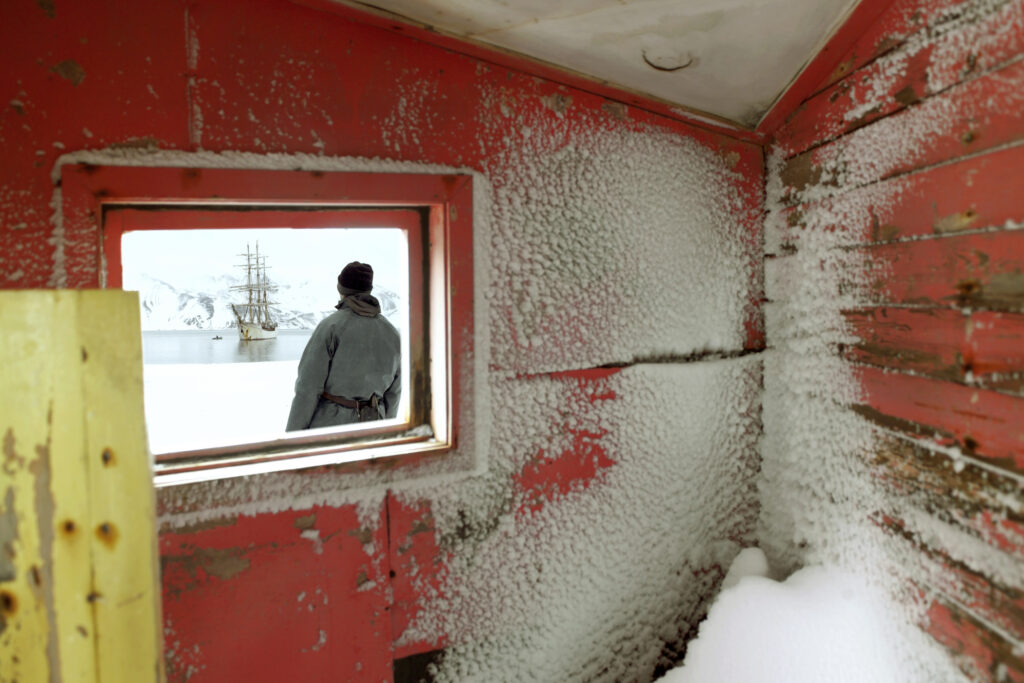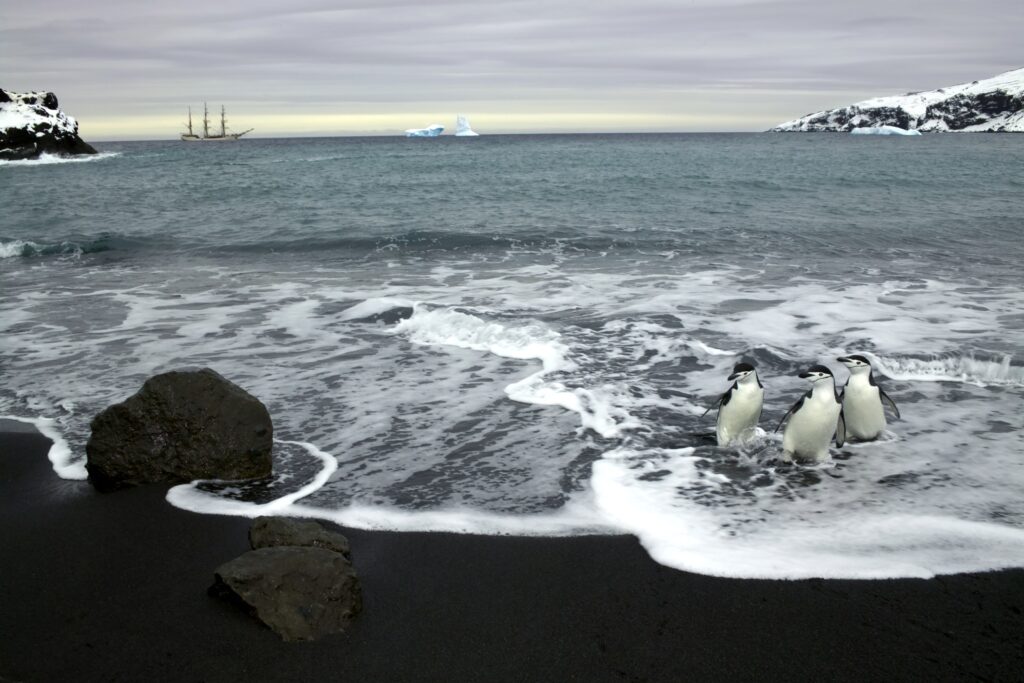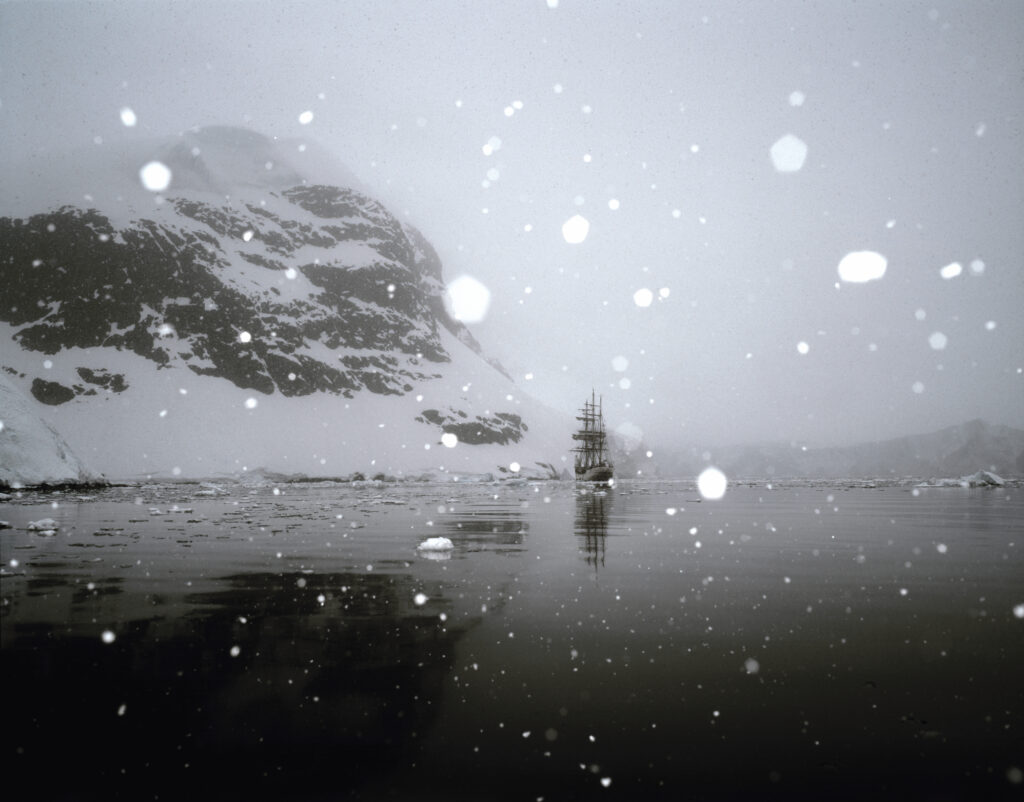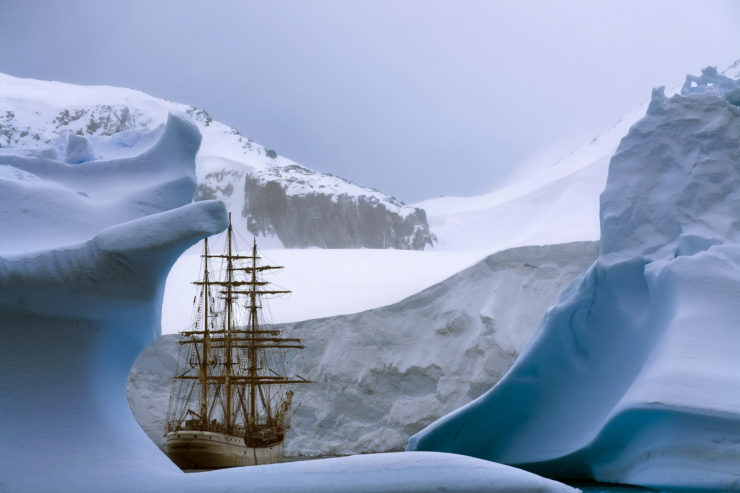In the competitive world of professional photography, René Koster takes a back seat to his subjects. His photos don’t scream out, “Hey, look how clever I am!” but rather they whisper, “Psst, this is how it is.”
The Dutch travel and portrait photographer is a master of light, composition and aesthetic subtlety, giving us photos that look mostly super natural, and sometimes supernatural.
He doesn’t dominate his pictures with gimmicks like tilted horizons, coerced expressions or digital manipulation that push the photographer’s style front and center. When I look at his photographs, I say, “Wow, that’s a far-out place!” or “God, what a wonderful face!”
The visual storytelling site Maptia recently featured the photographs Koster took during a voyage to Antarctica aboard the 1911 tall ship the Bark Europa. Koster says his intent was to travel back “to a time that once was … searching for stillness, harmony and tragedy in the landscape.” He found glacial stillness, and more, in a remote place where early 20th century photographers and explorers of the South Pole moved agonizingly slowly toward, and sometimes away from, survival.
When you look at Koster’s gallery, try not to click through it like you’re on Facebook or Instagram. Slow down and explore each photo at full-screen size. Try to feel the stillness and harmony that he sought. Some of these pictures are OMG! Others are hushed, like the plastering of new snow on a red wall and the towering monuments of ancient blue ice.
Koster is a visual explorer who treasures the finished images as well as the life-affirming experience of making them. I asked him to tell us about some of the stuff we don’t see in his photos. For his response to the question, “Was it quiet enough to hear the snowflakes falling on your parka?” he turns completely inward to the sound of blood coursing through his veins.
I spoke with Koster via email. Some of the answers have been slightly edited.
Your photograph of the Bark Europa framed by glaciers is a haunting reminder of an image that photographer Frank Hurley made of the tall ship Endurance during the 1915 Shackleton voyage. As you gazed through the viewfinder to compose the photo of your 100-year-old sailing ship, did you feel any spiritual connection to Hurley?
I have always had a keen interest in history -- the stories of the great expeditions to Antarctica that took place early 20th century, to discover this continent, still unknown back then.
During my time at the Art Academy, I was already fascinated by the work of Frank Hurley (1885 – 1962), especially the photographs he took off Shackleton's tall ship Endurance trapped in the Antarctic pack ice. He took these photographs at night and used a flash; I felt like I was watching negatives and remember being very impressed.
For me, the thought of the Bark Europa having been built the same period as the last great expeditions left for Antarctica intensified my own journey.

Your photo of the Europa through the window of the snow-blasted red shack rivets the eye on the beautifully composed high key scene in the distance. Did you feel like you were looking back in time, even though it seems you are standing in a tourist shelter or research settlement?
The red shack is a cabin that is situated on Deception Island. This island has a history of human occupation dating from 1911, when a whaling station was established in Whalers Bay by Norway. It closed in 1931 due to a slump in prices of whale oil.
The concept for the Antarctica project was indeed going back in time. The sailor standing in front of the cabin wears clothes similar to those of 50 or 100 years ago. I tried to avoid elements that would be a reminder of the modern time. But then I was struck by the authentic colors of the cabin's interiors; it was like being swept back into the present time.
I can almost hear the hum of the motor on the skiff carrying six of your fellow excursion explorers dressed in neon orange. Did sound travel for long distances on that day? Did your voice echo off the glacial walls or across the icy cold water?
The Bark Europa carried several dinghies and sloops on board, thus making it possible to explore locations the ship could not reach. Approaching the icebergs closely, you could hear the cracking of the ice. And it sounded like thunder echoing in a far distance.
One time while returning to the ship the dinghies, we were followed by a group of killer whales. We could hear the excited yells of the people who were watching us from the ship, while in the dinghy all was quiet and nobody dared to move. The dinghy was still a long distance from the Bark Europa. I assume that under other circumstances we would not have heard the people on the ship. But this time, it was as if these men and women were right next to us.
When I’m photographing in the remote deserts of the American Southwest, the silence of the landscape can be just as wonderful as the visual. On your overland hikes away from the ship were you able to experience any time completely devoid of voices, sniffles, footsteps, motors or generators? Was it quiet enough to hear snowflakes falling on your parka?
At night when most of the people were fast asleep and the atmosphere was quiet, I used to go on deck. On some of those occasions, it was snowing and there was absolute silence; I imagined the only thing I could hear was the sound of my blood running through my veins.

The three penguins wading ashore on the black sand beach look as though they were not bothered by your presence. And your portrait of the woman next to the shack includes a bird perched comfortably on the gable. Was the wildlife you encountered curious, aggressive or blissfully naïve toward people?
Probably blissfully naive, but although it may sound unfriendly, I rather call it indifferent. I do not want to disturb the wildlife and always keep a certain distance. When I was there, standing on the beach, the three penguins looked as surprised as I was. They came out the dark foamy waters, stopped to stare at me for a brief moment and then went on with their daily routines.
Photographing snow can be a technical challenge. Many of your landscape exposures hold the texture and tones in all but the brightest cliffs and snowdrifts. It’s logical that exposure compensation for those highlights might darken the exposure of the water. What was the true color of the sea when you looked straight down into it? Was the water clear?
In the Antarctic, one can experience different seasons in one day. The weather has a huge influence on the color of the water, causing a constant change in hue. We had a few days with lots of sunshine, and the water took on the intense dark blue shades of the sky, making it possible to look into the depth. Gazing at the shallow parts of the waters, you could see how crystal-clear the water actually is. The elements enabled me to emphasize the hardship I wanted to show in my work. The haziness made the ship, far away in the landscape, look frail, giving the photograph a sense of desolation. Another photograph shows ferocious waves that seemed to absorb the dark shades of the clouds above, becoming even more threatening.

In two of your photographs, your use of on-camera flash adds a gossamer veil of falling snowflakes between the viewer and the distant seascapes. It’s a masterful technique that adds depth to impossibly “flat” scenes. Were you satisfied with your modern digital photo gear that enabled you to travel light and record high-resolution pictures? As you climbed up and down shipboard ladders, scrambled in and out of lifeboats, and hiked over ice and snow, did you happen to think of the glass plate burden of your photographic predecessors?
In the past, I used to work a lot with a 4 x 5-inch plate camera when shooting portraits. I don't know how photographers like Hurley maintained similar cameras in such harsh conditions; it is impossible to operate these large and heavy cameras while wearing gloves. But without gloves, in a few seconds, your fingers go numb because of the cold.
Every time, getting in and out of the boat was a hassle, even without modern lightweight gear. Especially having to leave the dinghy to climb onto the main ship.
For the Antarctica project, I used two different cameras: a digital one and an old analogue Mamiya 7 II with a viewfinder. Not being convinced about the quality of this early digital camera, I took the Mamiya with me as well.
How did taking an antique ship influence your work? How were your photographs different from those you might have taken a modern, fast ship?
I once traveled with the Queen Elizabeth II from South Hampton England to New York. Great ocean steamers like the QEII have all these incredible luxurious facilities on board: casinos, swimming pools.
After that, many journeys followed; I traveled to Greenland, the Lofoten, Iceland, the Orkneys. I had the pleasure of working on a large range of ships, from barges and sailing ships to large cruise ships, most of which were built traditionally.
You will not find any signs of luxury on a tall ship like the Bark Europa, but nevertheless, it has so much to offer. Making a journey by a tall ship with such long history is extraordinary; feeling exposed to wind and weather. I felt that the slow rate of traveling by sailing ship influenced my way of taking photographs.

I love this line from your artist statement: "A journey of longing, to a time that once was. A heroic saga; filled with hardship and adventure, in an infinite, barren land." So lovely. Can you talk about it a bit more about the heroics and hardship, of both the past explorers and your own journey? How did that motivate you?
I had in mind Shackelton and his journeys to this remote barren land. These journeys were filled with misfortune, but at the same time, they demonstrate such an admirable persistence. Going to a remote and unknown area with such opportunism is almost like having the ingredients for a Greek tragedy. And Shackelton and his crew really had to suffer a great deal.
There's such poetry in this line: "searching for stillness, harmony, and tragedy in the landscape. In search of beauty, the beauty of emptiness and cold." There is conflict inherent in each sentence: harmony and tragedy, beauty and emptiness. Do you look for conflicts, and opposites, in your work?
Not necessarily, but conflicts tend to occur inevitably. My Antarctica project was once featured in Shots Magazine, and if I may, I would like to quote a comment one of the readers sent me: " How can it look so cold and yet so pretty... " I was very pleased to receive her note.
Do you create stories in your head about the images you create?
Yes, there is a kind of concept of the story before I start taking photographs. For every journey, I prepare by collecting information about the area and its history. This enables me to form an idea about the story I want to tell through my work. Then, my focus shifts towards finding the right pictures that fit in the story.
I decided to create a "story of a journey of longing, to a time that once was. A heroic saga; filled with hardship and adventure, in an infinite, barren land."
The image of the antique wooden ship seemingly frozen in the blue ice, like it is marooned, waiting for a rescue that may never come. Stunning. What did you want people to feel when they saw it?
I think you describe it perfectly!
The Dutch travel and portrait photographer is a master of light, composition and aesthetic subtlety, giving us photos that look mostly super natural, and sometimes supernatural.
He doesn’t dominate his pictures with gimmicks like tilted horizons, coerced expressions or digital manipulation that push the photographer’s style front and center. When I look at his photographs, I say, “Wow, that’s a far-out place!” or “God, what a wonderful face!”
The visual storytelling site Maptia recently featured the photographs Koster took during a voyage to Antarctica aboard the 1911 tall ship the Bark Europa. Koster says his intent was to travel back “to a time that once was … searching for stillness, harmony and tragedy in the landscape.” He found glacial stillness, and more, in a remote place where early 20th century photographers and explorers of the South Pole moved agonizingly slowly toward, and sometimes away from, survival.
When you look at Koster’s gallery, try not to click through it like you’re on Facebook or Instagram. Slow down and explore each photo at full-screen size. Try to feel the stillness and harmony that he sought. Some of these pictures are OMG! Others are hushed, like the plastering of new snow on a red wall and the towering monuments of ancient blue ice.
Koster is a visual explorer who treasures the finished images as well as the life-affirming experience of making them. I asked him to tell us about some of the stuff we don’t see in his photos. For his response to the question, “Was it quiet enough to hear the snowflakes falling on your parka?” he turns completely inward to the sound of blood coursing through his veins.
I spoke with Koster via email. Some of the answers have been slightly edited.
Your photograph of the Bark Europa framed by glaciers is a haunting reminder of an image that photographer Frank Hurley made of the tall ship Endurance during the 1915 Shackleton voyage. As you gazed through the viewfinder to compose the photo of your 100-year-old sailing ship, did you feel any spiritual connection to Hurley?
I have always had a keen interest in history -- the stories of the great expeditions to Antarctica that took place early 20th century, to discover this continent, still unknown back then.
During my time at the Art Academy, I was already fascinated by the work of Frank Hurley (1885 – 1962), especially the photographs he took off Shackleton's tall ship Endurance trapped in the Antarctic pack ice. He took these photographs at night and used a flash; I felt like I was watching negatives and remember being very impressed.
For me, the thought of the Bark Europa having been built the same period as the last great expeditions left for Antarctica intensified my own journey.

Your photo of the Europa through the window of the snow-blasted red shack rivets the eye on the beautifully composed high key scene in the distance. Did you feel like you were looking back in time, even though it seems you are standing in a tourist shelter or research settlement?
The red shack is a cabin that is situated on Deception Island. This island has a history of human occupation dating from 1911, when a whaling station was established in Whalers Bay by Norway. It closed in 1931 due to a slump in prices of whale oil.
The concept for the Antarctica project was indeed going back in time. The sailor standing in front of the cabin wears clothes similar to those of 50 or 100 years ago. I tried to avoid elements that would be a reminder of the modern time. But then I was struck by the authentic colors of the cabin's interiors; it was like being swept back into the present time.
I can almost hear the hum of the motor on the skiff carrying six of your fellow excursion explorers dressed in neon orange. Did sound travel for long distances on that day? Did your voice echo off the glacial walls or across the icy cold water?
The Bark Europa carried several dinghies and sloops on board, thus making it possible to explore locations the ship could not reach. Approaching the icebergs closely, you could hear the cracking of the ice. And it sounded like thunder echoing in a far distance.
One time while returning to the ship the dinghies, we were followed by a group of killer whales. We could hear the excited yells of the people who were watching us from the ship, while in the dinghy all was quiet and nobody dared to move. The dinghy was still a long distance from the Bark Europa. I assume that under other circumstances we would not have heard the people on the ship. But this time, it was as if these men and women were right next to us.
When I’m photographing in the remote deserts of the American Southwest, the silence of the landscape can be just as wonderful as the visual. On your overland hikes away from the ship were you able to experience any time completely devoid of voices, sniffles, footsteps, motors or generators? Was it quiet enough to hear snowflakes falling on your parka?
At night when most of the people were fast asleep and the atmosphere was quiet, I used to go on deck. On some of those occasions, it was snowing and there was absolute silence; I imagined the only thing I could hear was the sound of my blood running through my veins.

The three penguins wading ashore on the black sand beach look as though they were not bothered by your presence. And your portrait of the woman next to the shack includes a bird perched comfortably on the gable. Was the wildlife you encountered curious, aggressive or blissfully naïve toward people?
Probably blissfully naive, but although it may sound unfriendly, I rather call it indifferent. I do not want to disturb the wildlife and always keep a certain distance. When I was there, standing on the beach, the three penguins looked as surprised as I was. They came out the dark foamy waters, stopped to stare at me for a brief moment and then went on with their daily routines.
Photographing snow can be a technical challenge. Many of your landscape exposures hold the texture and tones in all but the brightest cliffs and snowdrifts. It’s logical that exposure compensation for those highlights might darken the exposure of the water. What was the true color of the sea when you looked straight down into it? Was the water clear?
In the Antarctic, one can experience different seasons in one day. The weather has a huge influence on the color of the water, causing a constant change in hue. We had a few days with lots of sunshine, and the water took on the intense dark blue shades of the sky, making it possible to look into the depth. Gazing at the shallow parts of the waters, you could see how crystal-clear the water actually is. The elements enabled me to emphasize the hardship I wanted to show in my work. The haziness made the ship, far away in the landscape, look frail, giving the photograph a sense of desolation. Another photograph shows ferocious waves that seemed to absorb the dark shades of the clouds above, becoming even more threatening.

In two of your photographs, your use of on-camera flash adds a gossamer veil of falling snowflakes between the viewer and the distant seascapes. It’s a masterful technique that adds depth to impossibly “flat” scenes. Were you satisfied with your modern digital photo gear that enabled you to travel light and record high-resolution pictures? As you climbed up and down shipboard ladders, scrambled in and out of lifeboats, and hiked over ice and snow, did you happen to think of the glass plate burden of your photographic predecessors?
In the past, I used to work a lot with a 4 x 5-inch plate camera when shooting portraits. I don't know how photographers like Hurley maintained similar cameras in such harsh conditions; it is impossible to operate these large and heavy cameras while wearing gloves. But without gloves, in a few seconds, your fingers go numb because of the cold.
Every time, getting in and out of the boat was a hassle, even without modern lightweight gear. Especially having to leave the dinghy to climb onto the main ship.
For the Antarctica project, I used two different cameras: a digital one and an old analogue Mamiya 7 II with a viewfinder. Not being convinced about the quality of this early digital camera, I took the Mamiya with me as well.
How did taking an antique ship influence your work? How were your photographs different from those you might have taken a modern, fast ship?
I once traveled with the Queen Elizabeth II from South Hampton England to New York. Great ocean steamers like the QEII have all these incredible luxurious facilities on board: casinos, swimming pools.
After that, many journeys followed; I traveled to Greenland, the Lofoten, Iceland, the Orkneys. I had the pleasure of working on a large range of ships, from barges and sailing ships to large cruise ships, most of which were built traditionally.
You will not find any signs of luxury on a tall ship like the Bark Europa, but nevertheless, it has so much to offer. Making a journey by a tall ship with such long history is extraordinary; feeling exposed to wind and weather. I felt that the slow rate of traveling by sailing ship influenced my way of taking photographs.

I love this line from your artist statement: "A journey of longing, to a time that once was. A heroic saga; filled with hardship and adventure, in an infinite, barren land." So lovely. Can you talk about it a bit more about the heroics and hardship, of both the past explorers and your own journey? How did that motivate you?
I had in mind Shackelton and his journeys to this remote barren land. These journeys were filled with misfortune, but at the same time, they demonstrate such an admirable persistence. Going to a remote and unknown area with such opportunism is almost like having the ingredients for a Greek tragedy. And Shackelton and his crew really had to suffer a great deal.
There's such poetry in this line: "searching for stillness, harmony, and tragedy in the landscape. In search of beauty, the beauty of emptiness and cold." There is conflict inherent in each sentence: harmony and tragedy, beauty and emptiness. Do you look for conflicts, and opposites, in your work?
Not necessarily, but conflicts tend to occur inevitably. My Antarctica project was once featured in Shots Magazine, and if I may, I would like to quote a comment one of the readers sent me: " How can it look so cold and yet so pretty... " I was very pleased to receive her note.
Do you create stories in your head about the images you create?
Yes, there is a kind of concept of the story before I start taking photographs. For every journey, I prepare by collecting information about the area and its history. This enables me to form an idea about the story I want to tell through my work. Then, my focus shifts towards finding the right pictures that fit in the story.
I decided to create a "story of a journey of longing, to a time that once was. A heroic saga; filled with hardship and adventure, in an infinite, barren land."
The image of the antique wooden ship seemingly frozen in the blue ice, like it is marooned, waiting for a rescue that may never come. Stunning. What did you want people to feel when they saw it?
I think you describe it perfectly!



